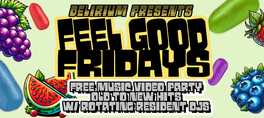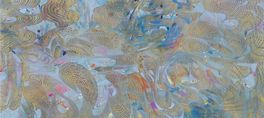The Jayhawks were definitely swimming against the tide when they emerged from a crowded Minneapolis music scene halfway through the 1980s — a memorable decade that saw the likes of the Replacements, Soul Asylum, Husker Du and Prince put Minnesota on the musical map in a big way. Forging a rootsy sound that wasn’t quite rock or country — “Hank Williams on speed” somebody once memorably called it — The Jayhawks quickly turned into one of the most important bands of the post-punk era. Over the course of two decades, several albums, countless memorable live shows and enough personal drama to fill a couple of Behind the Music episodes, this beloved band soared to heights few ever achieve while wining the hearts and minds of numerous critics, fans and peers in the process. Named after “The Hawks” — as in “Levon and the Hawks,” the name of Dylan’s backing band in the 60s before they became known as “The Band” — The Jayhawks and their fellow travelers even helped make the world safe again for artists who weren’t afraid to fuse traditional rock, country and folk influences into something that was both timeless and modern, just like the best American bands always have.Formed by Mark Olson, Gary Louris, Marc Perlman and Norm Rogers in early 1985, The Jayhawks original members all came from a variety of Minneapolis bands toiling away in the hyperactive local club scene at the time. Prolific and highly motivated, the band amassed a staggering number of original songs in a very short time, culminating with a self-released eponymous debut album in 1986. After a tumultuous period that found the band actively seeking a recording contract, The Jayhawks finally landed with Twin/Tone Records, the seminal Minneapolis indie label that released early records by the Replacements and Soul Asylum. Blue Earth, released in 1989, was a quantum leap forward from the first album and garnered widespread positive reviews. It also caught the ear of Def American producer/A&R rep George Drakoulias, who legendarily heard Blue Earth playing in the background during a call to the Twin/Tone offices.Drakoulias’ interest eventually led to a contract with Def American and the release of the band’s two best known albums, Hollywood Town Hall (1992) and Tomorrow the Green Grass (1995), which featured some of their best known songs (“Blue,” “Waiting For the Sun”). Supplemented by new members Karen Grotberg on keyboards and drummer/vocalist Tim O’Reagan, the Jayhawks toured steadily during this time and developed a solid reputation as an ace live band and a force to be reckoned with in the burgeoning “Americana” scene, an association the band has always viewed with mixed feelings. During this “golden age,” it seemed that The Jayhawks were always a break or two away from major stardom; their potential was as limitless as the pile of classic songs they were cranking out apparently at will.Frustrated by the major label rat race, founding member Mark Olson suddenly quit the band in late 1995, shocking fans and fellow band members alike. Olson packed up and headed to the Mojave Desert with his new wife, singer Victoria Williams, to embark on a solo career unencumbered by the restrictions inherent to the corporate music business. Louris and the rest of the band laid low for a while and then surprised nearly everyone by continuing on without Olson while keeping the band name. Augmented by Kraig Johnson (Run Westy Run) and Jessy Greene (Geraldine Fibbers), and paying little heed to their previous playbook, The Jayhawks released Sound of Lies in 1997, a dark, moody modern pop masterpiece that evoked fond memories of everything from Big Star to The Beatles.To prove that they really had wiped the old slate clean, the band enlisted flamboyant uber-producer Bob Ezrin for their next album, Smile (2000). Teeming with an adventurous spirit and some of the best songs Louris had written to date, Smile boldly charted new territory for the band (even incorporating drum machines into a Technicolor soundscape that hinted at everything from hard rock to psychedelia), effectively providing a clean break with their supposed traditional roots. Many long time fans were befuddled but the New York Times called Smile “a classic.” The band’s live shows during this period (with Jen Gunderman replacing Grotberg, who left to raise a family) found the band at the top of their game, with shows routinely running over 2 hours and featuring a healthy dose of Olson-era material, pleasing new and old fans alike.After a revelatory acoustic tour in 2003 with the core trio of Louris, Perlman and O’Reagan, the next chapter in The Jayhawks Saga found them retrenching somewhat to the “classic” sound of their earlier albums. Sparingly produced by Ethan Johns, Rainy Day Music was chock full of catchy songs (“Save It For a Rainy Day,” “Tailspin”) that tied together sounds and influences from every chapter of the band’s career. The band — now reduced to a trio, supplemented by touring member Stephen McCarthy, a veteran roots rocker (Long Ryders) and talented multi-instrumentalist — mounted the heaviest touring schedule and promotional blitz of their career, resulting in their highest charting album ever.Sadly, the momentum couldn’t be sustained and one of the most exciting American bands in recent history quietly went on hiatus in 2004. The ensuing years found Louris, Perlman and O’Reagan embarking on a variety of endeavors; all three have released solo projects in recent years. Louris also kept busy with a multitude of songwriting collaborations, production work, soundtracks and even the revival of longtime side-project, Golden Smog, a proverbial “supergroup” featuring members of Soul Asylum, Wilco and Big Star, as well as Jayhawkers Perlman and Johnson. Significantly, after years of estrangement, Olson and Louris finally reunited for a couple of well-received tours, followed by Ready For the Flood in 2009, their first full length studio venture together in 15 years.Even though the door to the future was never officially closed, long time fans were still surprised — and overjoyed — with the news in 2008 that the Tomorrow the Green Grass-era lineup of the band with Mark Olson would be reuniting for some summer festival shows in Europe. The good news kept on coming in 2009 with more reunion shows and the release of the band’s first retrospective, Music From the North Country, a multi-disc collection personally supervised by Louris that featured key tracks from all phases of the bands career, a disc of rarities and a DVD. 2010 saw the long awaited re-release of the bands long out-of-print, highly collectable first album, as well as the launch of a massive reissue project of all the band’s major label albums. During June 2010, the “classic” lineup of the band performed a three night stand at Minneapolis’ legendary First Ave. club, the scene of so many great Jayhawks memories over the last quarter century. In 2011, deluxe editions of the esteemed Hollywood Town Hall and Tomorrow the Green Grass albums were reissued, followed by Mockingbird Time, the first release of new material by The Jayhawks with Mark Olson in 16 years. From 2009-2012 this version of the band played over 100 shows to large crowds and received numerous rave reviews.The second phase of The Jayhawks reissue project commenced in June 2014 with the reissue of the Sound of Lies, Smile and Rainy Day Music albums. The Summer of 2014 found most of the 1997 touring lineup (Gary Louris, Marc Perlman, Tim O'Reagan, Karen Grotberg and Kraig Johnson) playing some North American festival dates and hitting the road in Europe to get the ball rolling in a concerted effort to reacquaint audiences with these crucial albums. Further North American dates are planned for the fall of 2014 – the first US Jayhawks tour in over two years. 2014 setlists have seen a heavy emphasis on the 1997-2004 era mixed in with selected material from other periods in the band's long history. The Jayhawks have made music in 4 different decades and are as vital now as they were in 1985. They definitely have earned their reputation as a true American treasure.
show less
The Jayhawks were definitely swimming against the tide when they emerged from a crowded Minneapolis music scene halfway through the 1980s — a memorable decade that saw the likes of the Replacements, Soul Asylum, Husker Du and Prince put Minnesota on the musical map in a big way. Forging a rootsy sound that wasn’t quite rock or country — “Hank Williams on speed” somebody once memorably called it — The Jayhawks quickly turned into one of the most important bands of the post-punk era. Over the course of two decades, several albums, countless memorable live shows and enough personal drama to fill a couple of Behind the Music episodes, this beloved band soared to heights few ever achieve while wining the hearts and minds of numerous critics, fans and peers in the process. Named after “The Hawks” — as in “Levon and the Hawks,” the name of Dylan’s backing band in the 60s before they became known as “The Band” — The Jayhawks and their fellow travelers even helped make the world safe again for artists who weren’t afraid to fuse traditional rock, country and folk influences into something that was both timeless and modern, just like the best American bands always have.Formed by Mark Olson, Gary Louris, Marc Perlman and Norm Rogers in early 1985, The Jayhawks original members all came from a variety of Minneapolis bands toiling away in the hyperactive local club scene at the time. Prolific and highly motivated, the band amassed a staggering number of original songs in a very short time, culminating with a self-released eponymous debut album in 1986. After a tumultuous period that found the band actively seeking a recording contract, The Jayhawks finally landed with Twin/Tone Records, the seminal Minneapolis indie label that released early records by the Replacements and Soul Asylum. Blue Earth, released in 1989, was a quantum leap forward from the first album and garnered widespread positive reviews. It also caught the ear of Def American producer/A&R rep George Drakoulias, who legendarily heard Blue Earth playing in the background during a call to the Twin/Tone offices.Drakoulias’ interest eventually led to a contract with Def American and the release of the band’s two best known albums, Hollywood Town Hall (1992) and Tomorrow the Green Grass (1995), which featured some of their best known songs (“Blue,” “Waiting For the Sun”). Supplemented by new members Karen Grotberg on keyboards and drummer/vocalist Tim O’Reagan, the Jayhawks toured steadily during this time and developed a solid reputation as an ace live band and a force to be reckoned with in the burgeoning “Americana” scene, an association the band has always viewed with mixed feelings. During this “golden age,” it seemed that The Jayhawks were always a break or two away from major stardom; their potential was as limitless as the pile of classic songs they were cranking out apparently at will.Frustrated by the major label rat race, founding member Mark Olson suddenly quit the band in late 1995, shocking fans and fellow band members alike. Olson packed up and headed to the Mojave Desert with his new wife, singer Victoria Williams, to embark on a solo career unencumbered by the restrictions inherent to the corporate music business. Louris and the rest of the band laid low for a while and then surprised nearly everyone by continuing on without Olson while keeping the band name. Augmented by Kraig Johnson (Run Westy Run) and Jessy Greene (Geraldine Fibbers), and paying little heed to their previous playbook, The Jayhawks released Sound of Lies in 1997, a dark, moody modern pop masterpiece that evoked fond memories of everything from Big Star to The Beatles.To prove that they really had wiped the old slate clean, the band enlisted flamboyant uber-producer Bob Ezrin for their next album, Smile (2000). Teeming with an adventurous spirit and some of the best songs Louris had written to date, Smile boldly charted new territory for the band (even incorporating drum machines into a Technicolor soundscape that hinted at everything from hard rock to psychedelia), effectively providing a clean break with their supposed traditional roots. Many long time fans were befuddled but the New York Times called Smile “a classic.” The band’s live shows during this period (with Jen Gunderman replacing Grotberg, who left to raise a family) found the band at the top of their game, with shows routinely running over 2 hours and featuring a healthy dose of Olson-era material, pleasing new and old fans alike.After a revelatory acoustic tour in 2003 with the core trio of Louris, Perlman and O’Reagan, the next chapter in The Jayhawks Saga found them retrenching somewhat to the “classic” sound of their earlier albums. Sparingly produced by Ethan Johns, Rainy Day Music was chock full of catchy songs (“Save It For a Rainy Day,” “Tailspin”) that tied together sounds and influences from every chapter of the band’s career. The band — now reduced to a trio, supplemented by touring member Stephen McCarthy, a veteran roots rocker (Long Ryders) and talented multi-instrumentalist — mounted the heaviest touring schedule and promotional blitz of their career, resulting in their highest charting album ever.Sadly, the momentum couldn’t be sustained and one of the most exciting American bands in recent history quietly went on hiatus in 2004. The ensuing years found Louris, Perlman and O’Reagan embarking on a variety of endeavors; all three have released solo projects in recent years. Louris also kept busy with a multitude of songwriting collaborations, production work, soundtracks and even the revival of longtime side-project, Golden Smog, a proverbial “supergroup” featuring members of Soul Asylum, Wilco and Big Star, as well as Jayhawkers Perlman and Johnson. Significantly, after years of estrangement, Olson and Louris finally reunited for a couple of well-received tours, followed by Ready For the Flood in 2009, their first full length studio venture together in 15 years.Even though the door to the future was never officially closed, long time fans were still surprised — and overjoyed — with the news in 2008 that the Tomorrow the Green Grass-era lineup of the band with Mark Olson would be reuniting for some summer festival shows in Europe. The good news kept on coming in 2009 with more reunion shows and the release of the band’s first retrospective, Music From the North Country, a multi-disc collection personally supervised by Louris that featured key tracks from all phases of the bands career, a disc of rarities and a DVD. 2010 saw the long awaited re-release of the bands long out-of-print, highly collectable first album, as well as the launch of a massive reissue project of all the band’s major label albums. During June 2010, the “classic” lineup of the band performed a three night stand at Minneapolis’ legendary First Ave. club, the scene of so many great Jayhawks memories over the last quarter century. In 2011, deluxe editions of the esteemed Hollywood Town Hall and Tomorrow the Green Grass albums were reissued, followed by Mockingbird Time, the first release of new material by The Jayhawks with Mark Olson in 16 years. From 2009-2012 this version of the band played over 100 shows to large crowds and received numerous rave reviews.The second phase of The Jayhawks reissue project commenced in June 2014 with the reissue of the Sound of Lies, Smile and Rainy Day Music albums. The Summer of 2014 found most of the 1997 touring lineup (Gary Louris, Marc Perlman, Tim O'Reagan, Karen Grotberg and Kraig Johnson) playing some North American festival dates and hitting the road in Europe to get the ball rolling in a concerted effort to reacquaint audiences with these crucial albums. Further North American dates are planned for the fall of 2014 – the first US Jayhawks tour in over two years. 2014 setlists have seen a heavy emphasis on the 1997-2004 era mixed in with selected material from other periods in the band's long history. The Jayhawks have made music in 4 different decades and are as vital now as they were in 1985. They definitely have earned their reputation as a true American treasure.
read more
show less
Category:
Date/Times:
The Fillmore
25 Upcoming Events
1805 Geary Blvd, San Francisco, CA 94115
The Best Events
Every Week in Your Inbox
From Our Sponsors
UPCOMING EVENTS
Great suggestion! We'll be in touch.
Event reviewed successfully.








